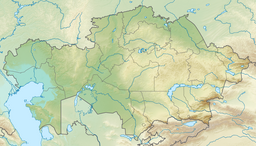Karasor (Kazakh: Қарасор; Russian: Карасор),[1][2] is a salt lake in Karkaraly District, Karaganda Region, Kazakhstan.[3][4]
| Karasor | |
|---|---|
| Қарасор | |
 Sentinel-2 image of the lake in June 2021 | |
| Location | Kazakh Uplands |
| Coordinates | 49°53′N 75°23′E / 49.883°N 75.383°E |
| Type | endorheic |
| Primary inflows | Taldy, Karasu, Yesenaman, Barak and Kemer |
| Primary outflows | none |
| Catchment area | 8,750 square kilometers (3,380 sq mi) |
| Basin countries | Kazakhstan |
| Max. length | 43 kilometers (27 mi) |
| Max. width | 7.3 kilometers (4.5 mi) |
| Surface area | 154 square kilometers (59 sq mi) |
| Average depth | 2.5 meters (8 ft 2 in) |
| Max. depth | 5 meters (16 ft) |
| Water volume | 160,000,000 cubic meters (5.7×109 cu ft) |
| Residence time | UTC+6 |
| Shore length1 | 103 kilometers (64 mi) |
| Surface elevation | 622 meters (2,041 ft) |
| Islands | Zhumyrtkaly and Araltabe |
| 1 Shore length is not a well-defined measure. | |
Karasor is the largest lake in Karaganda Region. It is located 45 kilometers (28 mi) to the north of Karkaraly city. There are no settlements by the lakeshore. The nearest inhabited pace is Koyandy village, close to the eastern end.[5] The mud at the bottom of the lake has medicinal properties.[6]
Geography
editKarasor is an endorheic lake in the central Kazakh Uplands. It stretches from east to west to the north of the Karkaraly Range and to the south of the Ayr Mountains. It is the largest of the lakes of the Karasor Basin, and is located at the bottom of the vast depression without drainage. Smaller lake Katynkol lies to the SW of the southern end, Saumalkol to the west, and Balyktykol 20 kilometers (12 mi) to the east. The shape of Karasor is sinuous, narrower in its central section. The bottom of the lake is mostly silt, with a smell of hydrogen sulfide. The lakeshores are complex, some stretches are clayey or pebbly, low and gently sloping, but in certain areas they are rocky, with cliffs reaching a height of 25 meters (82 ft). There are two little islands on the lake, Zhumyrtkaly and Araltabe.[1]
Fourteen small rivers flow into Karasor, including the 159 kilometers (99 mi) long Taldy, which flows into the eastern end of the lake. Other rivers are the Karkaralinka, Karsakpai, Karasu, Yesenaman, Barak and Kemer. Most of them dry up in the summer. On average, the highest water level of the lake is in April and the lowest in November. Karasor usually freezes in November and thaws in late April or early May.[5]
Flora and fauna
editThe land in the 8,750 square kilometers (3,380 sq mi) basin around Karasor includes plowed agricultural fields with clay and loam soils. The vegetation near the lakeshore zone is characteristic of the Kazakh steppe, including spear grass, wormwood, Siberian peashrub and fescue.[6][7]
Although the lake water is highly mineralized, with a concentration of 250 grams per liter (40 oz/imp gal) to 350 grams per liter (56 oz/imp gal), there are fish living in the lake. Every year at Karasor there is a large concentration of about 5,000 common shelducks during their moulting season.[8]
See also
editReferences
edit- ^ a b Карасор; Great Soviet Encyclopedia in 30 vols. — Ch. ed. A.M. Prokhorov. - 3rd ed. - M. Soviet Encyclopedia, 1969-1978. (in Russian)
- ^ Площадь озер Казахстана (Таблица)
- ^ "M-43 Topographic Chart (in Russian)". Retrieved 18 August 2022.
- ^ Lakes in the Central Kazakhstan
- ^ a b Google Earth
- ^ a b Jilili Abuduwaili, Gulnura Issanova, Galymzhan Saparov, Hydrology and Limnology of Central Asia. pp. 177-181
- ^ News of the National Academy of Sciences of the Republic of Kazakhstan
- ^ Karasor Lake - BirdLife Data Zone
External links
edit- Media related to Karasor at Wikimedia Commons
- Озеро Карасор в Казахстане (in Russian)
- Караганда: спасенный Карасор - степная лечебница (view of the lakeshore)
